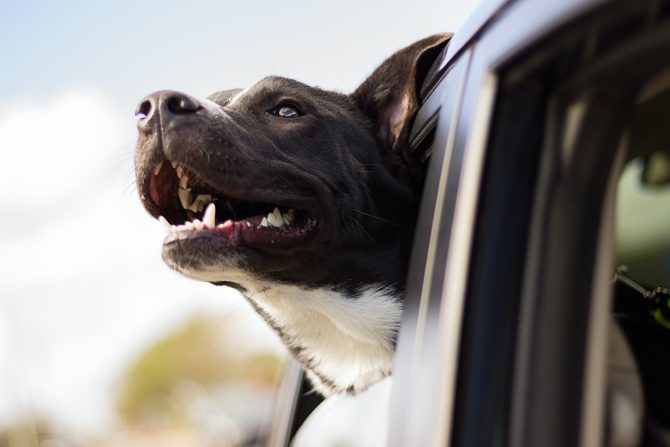Travelling by Ferry With Your Dog Between France and the UK
Essential Reading


If you’re travelling between France and the UK with a dog, one of the most popular ways to travel is to take the ferry. Here’s what you need to know about travelling to France by ferry with your dog.
Can you travel by ferry to France with a dog?
There are a number of different ferry companies and cross-channel ferry routes between France and the UK. The most popular include Portsmouth to Caen, St Malo, or Cherbourg (operated by Brittany Ferries), and Dover to Calais (operated by P&O Ferries, DFDS, and Irish Ferries).
Almost all routes and ships allow you to travel with a dog, with prices typically around £15 per dog. However, departure times, travel times, and rules for pet travel vary, so it’s important to choose the right option to suit your dog.
Pet-friendly cabins, kennels, and travelling in the car
There are a few different options for travelling with your pet by ferry. The most popular option is to leave your dog in your vehicle for the duration of the ferry crossing. If you choose this option, it is typically not possible to visit your pet during the journey (although exceptions will be made in an emergency).
However, on some crossings, pet-friendly kennels are also available, which enable you to visit your dog during the journey. Some ferry companies also offer pet-friendly cabins, which mean you can bring your dog on board with you. Note that most ferries require all dogs brought on board to wear a muzzle at all times.
Travel Documents and Requirements
Your dog will need to meet specific requirements and present certain documents in order to travel, and the rules are different depending on whether you (and your dog) are resident in France or the UK.
Travelling with an EU Passport
Dog owners resident in France can bring their dog to and from the UK with a valid EU Pet Passport. Your dog will need to be microchipped with up-to-date vaccines and rabies vaccines. Your dog must be wormed for tapeworm within 24-hours to five days of travel to the UK – this must be carried out by a vet who will also stamp their passport. There are no further requirements for returning to France with your pet.
Read the official rules for travel here.
Travelling to France with a dog post-Brexit
Since Brexit, UK-issued dog passports are no longer accepted for dogs travelling from the UK to France. Instead, your dog will need an Animal Health Certificate issued within ten days of your departure to France. Your vet can issue this for a fee of around €100, and it remains valid for four months of onward travel within the EU, including your return to the UK. Your dog must be microchipped and vaccinated for rabies in order to travel.
For returning to the UK, your dog will need to be wormed for tapeworm within 48 hours of departure. This must be carried out by a French vet who will issue proof of worming.
Read our article on Brexit and Pet Passports and read the official rules for travel here.
Preparing to travel to France with a Dog
As well as making sure your dog has the required travel documents, there are other things to consider when travelling with your dog. It’s a good idea to get your dog comfortable travelling in the car prior to undertaking a long journey. In both the UK and France, your dog will need to travel in the backseat or boot of the car and be suitably restrained (for example, with a net, cage, or travel harness) to ensure they cannot distract the driver while travelling. You should also get your dog used to being left alone in the car or in a kennel in preparation for travelling.
When to travel
It’s important to consider the weather, departure time, and duration of travel when travelling with a pet. Will you have time to exercise your dog before departure? How long will your dog be left alone? Are there any adjustments to your travel plans that might make it easier for your dog?
For example, an overnight ferry might be a smart choice for longer crossings or more energetic dogs, as your dog may be more likely to settle down and sleep for the duration of the journey. If travelling in mid-summer, try to avoid travelling during the hottest part of the day if possible.
What to pack
Travelling with your pet means you will also need to pack your dog’s essentials, including everything that you will need for both travelling and the duration of your trip. Here are a few of the essentials:
- Your dog’s bed (plus a suitable crate or harness for travel). Consider an extra blanket if travelling in winter or sun-guards if travelling in summer.
- A non-spill water bowl suitable for travel and plenty of water.
- A collar and identity tag (updated with your travel phone number if different).
- A towel (to clean off wet or muddy paws).
- Enough food (and some extra just in case) for the duration of your holiday (see note below on bringing dog food to France).
- Consider packing a few treats or a bone if you think it will help your dog settle or keep your dog occupied during the journey.
- Food bowls, toys, brushes, poo bags, and any other daily essentials you need for your dog.
- Muzzle if required by your transport provider.
- Flea or tick medication, especially if travelling in the summer months.
Can you bring dog food from the UK to France?
Post-Brexit travel regulations mean that it is no longer permitted to take any food (including dog food) that contains animal products – i.e. meat, dairy, or meat derivatives – from the UK into the EU. If you are travelling to France, be sure to check the packet and don’t assume that you will ‘get away with it’ (customs can and will confiscate the items, leaving you without food for your dog’s journey).
Only dog foods marked ‘vegan’ are permitted, and there is also an exception for special dog foods required for medical reasons (up to 2kg). You can read the full rules here.
Most popular brands of dry and wet dog foods will be available in France, so the best option is to purchase your dog’s food on arrival. For the journey, consider feeding your dog prior to arrival at the ferry port or purchasing vegan alternatives to take on board.
When travelling from France to the UK, there are no restrictions on bringing dog food for personal use.
Travelling with a Dog: Check-in Procedure
Give yourself extra time when travelling with a dog and plan a stop before arriving at the port to exercise your dog and allow them to go to the toilet. On arrival at the port, your dog should be safely secured for travel but visible to the customs attendants. You will need to present your dog’s passport, Animal Health Certificate, and/or tapeworm certification according to the above-mentioned rules.
You will not typically be asked to take your dog out of the vehicle, but you will be asked to scan your dog’s microchip, which you can do yourself using the handheld device. You will typically be given a sticker to attach to your vehicle windscreen indicating that there is a pet on board.
After passing through customs and passport controls, there may be time to take your dog out of the vehicle to walk around or have a final toilet break while you are waiting to board the ferry, but you will need to keep your dog on a lead. Some ports also require dogs to be muzzled if you leave your vehicle at the port, so bear this in mind.
Travelling with a Dog: On-board
Once onboard, take the time to prepare before you vacate your vehicle. If you are staying in a dog-friendly cabin or taking your dog to the onboard kennels, be sure to bring everything you need for the journey with you, including bowls, toys, your dog’s bed, and any food or water. Remember you will not be able to return to your vehicle during the crossing.
If your dog is staying in the car, make sure to prepare your dog for the journey before you leave. You should leave at least one or more windows ajar in your vehicle (even in winter), ensure your dog has enough fresh water and food for the journey, and any toys they may need.
Arriving in France or the UK with your Dog
You will be able to rejoin your vehicle and pet prior to the ferry arriving in port, typically around 30 minutes before. If your pet has been left alone for an extended period, remember that they will likely be excited to see you and also need to go to the toilet –try and keep your dog as calm as possible to avoid any accidents.
You will need to keep your dog in the vehicle until you descend the ferry and pass through customs and passports controls (typically, your dog’s documents will not need to be presented again upon arrival, but it’s wise to have them handy just in case).
Plan a stop as soon as possible after your leave the port in order to allow your dog to stretch his legs, go to the toilet, and get some fresh air before continuing on your journey.
Share to: Facebook Twitter LinkedIn Email
By FrenchEntrée
Leave a reply
Your email address will not be published. Required fields are marked *




REPLY
REPLY
REPLY
REPLY
REPLY
REPLY
REPLY
REPLY